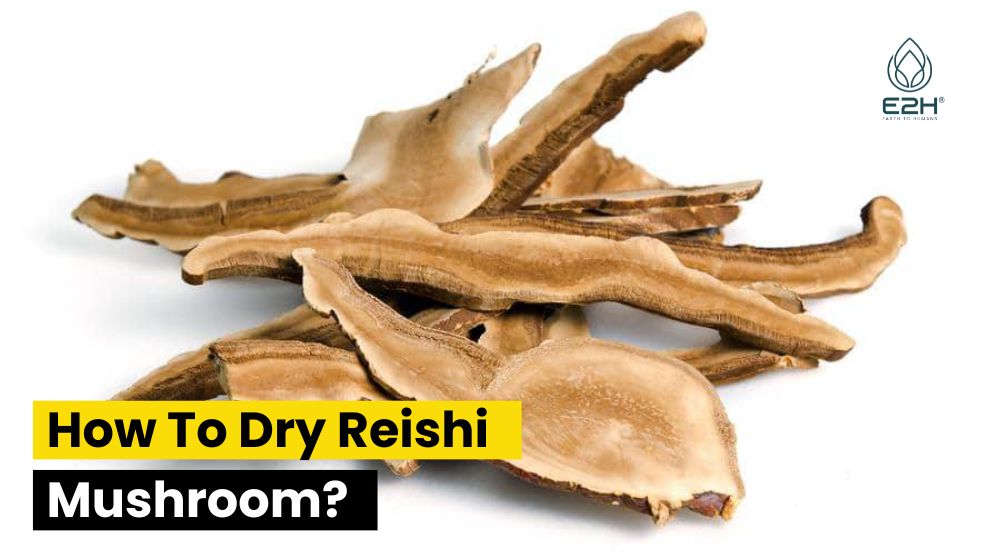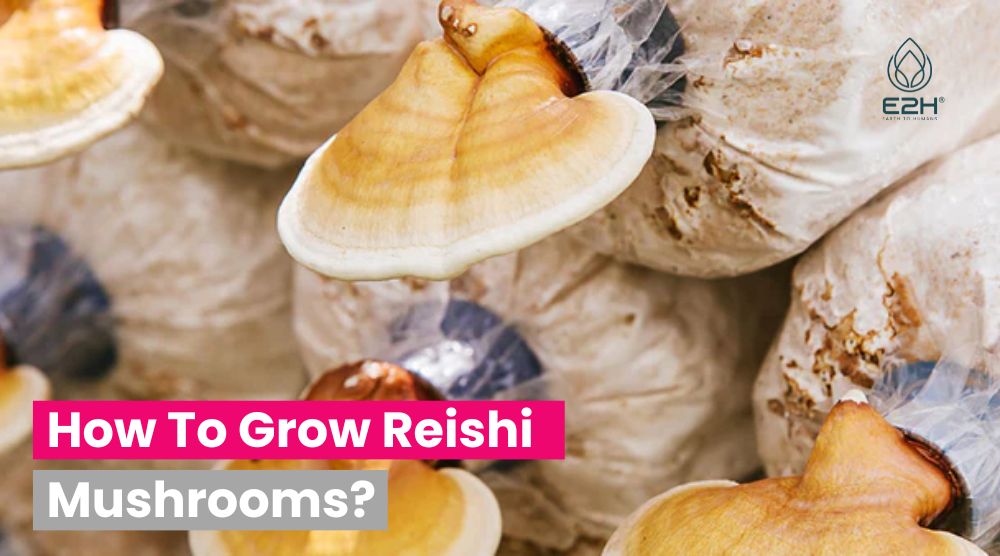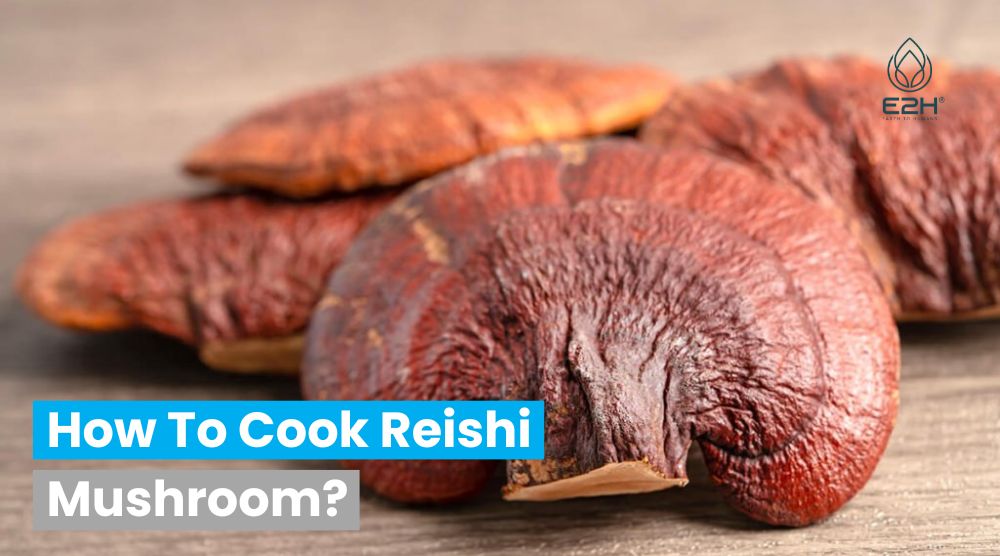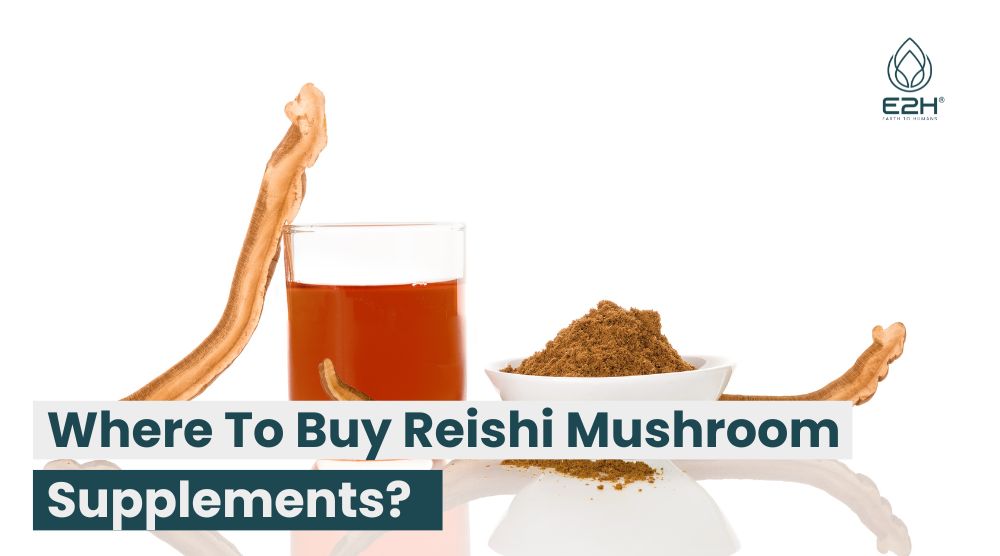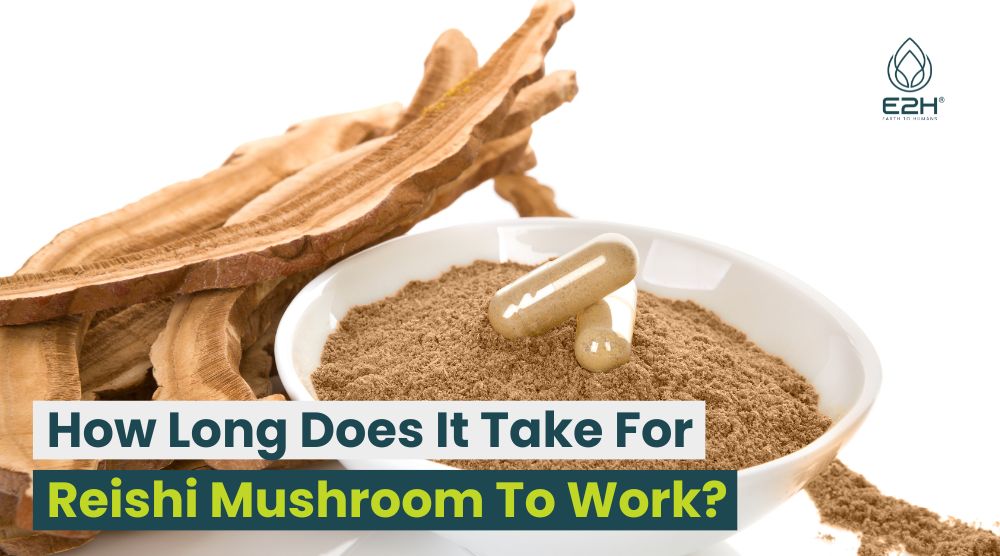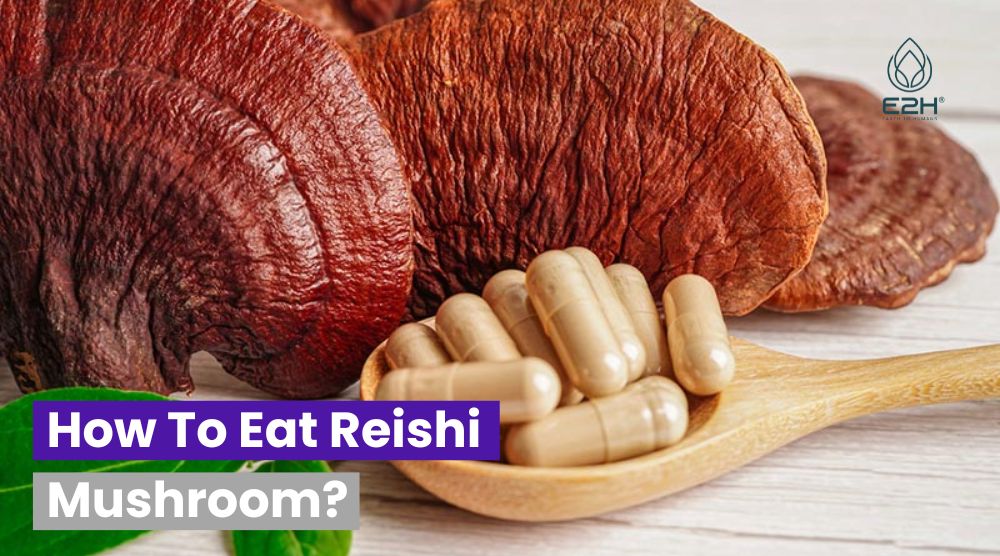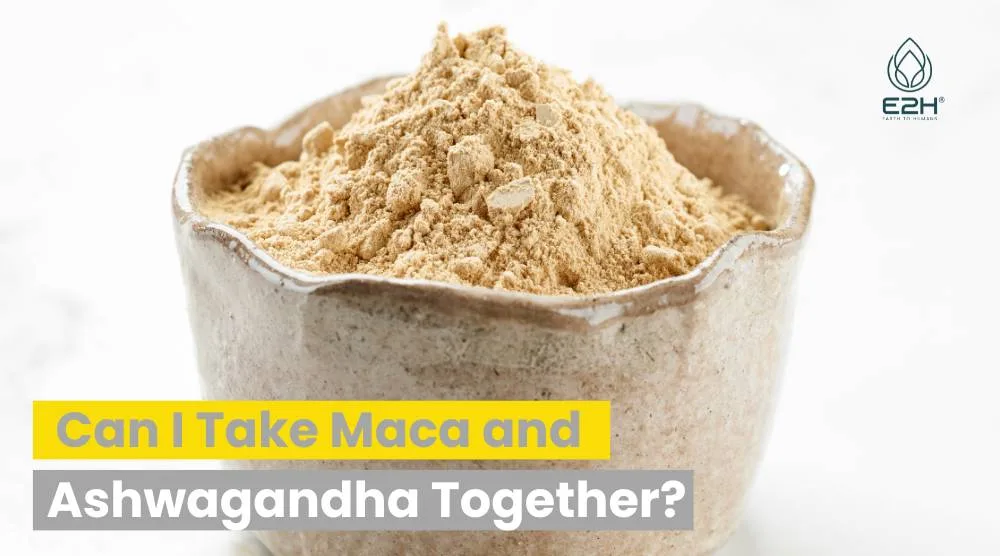I had a bunch of fresh Reishi mushrooms and didn’t want them to spoil, so I learned how to dry them! It was super easy.
How To Dry Reishi Mushroom: I just sliced the mushrooms thin, spread them on a baking sheet, and put them in the oven on low heat. After a few hours, they were totally dry. I stored them in a tight jar, and now I can make healthy Reishi tea anytime.
Tip: make sure they’re completely dry before storing to keep mold away. Plus, drying them brings out their earthy flavor, making my teas taste even better!
How To Dry Reishi Mushroom: Step by Step Process
Drying Reishi mushrooms is a great way to preserve their health benefits and earthy flavor. Here’s a simple step-by-step process:
- Clean the Mushrooms: Gently brush off any dirt from your Reishi mushrooms with a soft brush or a piece of cloth. Avoid washing them as they can absorb water.
- Slice the Mushrooms: Using a sharp knife, cut the Reishi mushrooms into thin slices. The thinner they are, the faster they will dry.
- Arrange for Drying: Lay the slices on a baking sheet in a single layer, ensuring they do not overlap. This allows for even drying.
- Oven Drying: Preheat your oven to the lowest setting, usually between 150-200°F (65-93°C). Place the baking sheet in the oven. Leave the oven door slightly ajar to allow moisture to escape.
- Check Regularly: Check the mushrooms every 30 minutes. Flip them occasionally to ensure they dry evenly.
- Dehydrator Option: If you have a food dehydrator, lay the slices on the dehydrator trays and set it to 115°F (46°C). It may take 8-10 hours to dry the mushrooms thoroughly.
- Test for Dryness: After several hours, check if the slices are brittle and snap easily. This means they are completely dry.
- Cool Down: Turn off the heat and let the mushrooms cool in the oven or dehydrator.
- Storage: Once cooled, place the dried Reishi slices in an airtight container and store them in a cool, dark place.

How do you prepare fresh Reishi mushrooms for drying?
Preparing fresh Reishi mushrooms for drying is a straightforward process. First, you’ll want to clean the mushrooms. Since Reishi mushrooms can be woody and tough, it’s best to use a soft brush or a dry cloth to gently remove any dirt or debris; they should not be washed with water as they’re highly absorbent and could become too moist.
Next, slice the Reishi mushrooms into thin strips; thinner slices will dry more quickly and evenly. If the mushrooms are particularly large, you can cut them into small pieces to ensure consistent drying. Once sliced, they’re ready to be placed in a dehydrator or oven, or to be air-dried. Remember, the key is to have uniform pieces to promote even drying and prevent any from remaining moist, which could lead to spoilage.
What is the best method to dry Reishi mushrooms at home?
The best method to dry Reishi mushrooms at home is using a food dehydrator. Here’s why:
- Even Drying: A dehydrator provides consistent heat and airflow, which means your Reishi mushrooms will dry evenly, preserving their quality and medicinal properties.
- Temperature Control: Dehydrators come with temperature controls that are perfect for mushrooms, usually around 95-115°F (35-46°C). This low temperature ensures that the mushrooms dry without cooking, keeping the important bioactive compounds intact.
- Efficiency: Dehydrators are designed to remove moisture quickly and efficiently, which reduces the risk of mold or spoilage. You can dry a large batch of mushroom slices in 8-10 hours, depending on the thickness.
- Convenience: With a dehydrator, you can set it and forget it. Once you’ve arranged your Reishi slices on the trays, you can leave the dehydrator to do its job without the need for constant checking.
Is there a specific temperature for drying Reishi mushrooms in a dehydrator?
Yes, there is a recommended temperature range for drying Reishi mushrooms in a dehydrator. Set your dehydrator to between 95-115°F (35-46°C). This low temperature range is ideal as it dries the mushrooms slowly and gently, preserving their medicinal qualities and preventing any potential heat damage to the enzymes and nutrients.
The drying time can vary depending on the thickness of the slices and the specific model of your dehydrator, but it typically takes between 8 to 12 hours for the Reishi mushrooms to become completely dry and brittle, indicating they are ready for storage.
How long does it take to air-dry Reishi mushrooms?
Air-drying Reishi mushrooms can take anywhere from a few days to a week, depending on the humidity and air circulation in your environment. For best results, slice the mushrooms thinly and place them in a warm, dry area with good airflow.
You can speed up the process by using a fan to circulate air around the mushrooms. Make sure to turn them occasionally for even drying. When the slices are brittle and snap easily, they’re fully dried and ready for storage. Always store them in an airtight container to keep them dry and protected from insects.
What are the steps to dry Reishi mushrooms using an oven?
To dry Reishi mushrooms in the oven, follow these steps:
- Preheat: Set your oven to the lowest temperature, ideally around 150-200°F (65-93°C).
- Prepare: Clean the mushrooms with a brush and slice them thinly for uniform drying.
- Arrange: Place the slices on a baking sheet in a single layer, ensuring they don’t overlap.
- Oven Door: Keep the oven door slightly open to allow moisture to escape and provide air circulation.
- Bake: Let the mushrooms dry for about 1-2 hours, checking every 30 minutes.
- Flip: Turn the slices occasionally to promote even drying.
- Test: The mushrooms are done when they are completely dry and brittle to the touch.
- Cool: Turn off the oven and let the mushrooms cool inside before storing them.
What are the benefits of drying Reishi mushrooms?
Drying Reishi mushrooms has several benefits. Firstly, it significantly extends their shelf life, allowing you to enjoy their health benefits year-round. Dried Reishi can be stored for months without losing their potent medicinal properties, which include boosting the immune system and providing anti-inflammatory effects.

Drying also concentrates the mushrooms’ bioactive compounds, potentially enhancing their healthful properties. Additionally, dried Reishi mushrooms are more versatile; they can be ground into powder for teas, tinctures, or capsules, or rehydrated for use in various recipes.
This process also makes them easier to store and transport, as they take up less space and are less prone to spoilage than their fresh counterparts.
How can I tell when Reishi mushrooms are completely dry and ready for storage?
You can tell that Reishi mushrooms are completely dry and ready for storage when they are brittle and snap easily when bent. The slices should have a very low moisture content, feeling light and dry to the touch.
There should be no soft or spongy parts, as this indicates remaining moisture which could lead to mold during storage. Before storing, let the mushrooms cool completely after drying to avoid any condensation that could introduce moisture.
Once dry, store them in an airtight container to protect from humidity and keep them in a cool, dark place to preserve their medicinal qualities and extend their shelf life.
What is the shelf life of dried Reishi mushrooms?
The shelf life of properly dried Reishi mushrooms is typically around 1 to 2 years. To ensure they last this long, they must be completely dry to the point of being brittle and stored in an airtight container to protect them from moisture and humidity.
Keeping them in a cool, dark place will also help preserve their potency and prevent degradation. It’s important to check the mushrooms periodically for any signs of spoilage, such as a musty smell or visible mold, which would indicate that they are no longer good to use.
Are there any safety concerns when drying Reishi mushrooms?
When drying Reishi mushrooms, there are a few safety concerns to keep in mind. First, ensure that the mushrooms are correctly identified as Reishi (Ganoderma lucidum) to avoid consuming toxic varieties.
Always start with clean, uncontaminated mushrooms to prevent the growth of harmful bacteria or mold during the drying process. It’s also important to dry the mushrooms at the correct temperature; too high can destroy beneficial compounds, while too low may not remove enough moisture, leading to spoilage.
Finally, if you have allergies to mold or fungi, handle and consume dried Reishi with caution, as the drying process can concentrate these allergens. Always store dried mushrooms in a cool, dark place to maintain their quality and safety.
What are some common uses for dried Reishi mushrooms?
Common Uses for Dried Reishi Mushrooms:
- Brewing into herbal tea for immune support.
- Grinding into powder for adding to smoothies or health shakes.
- Incorporating into soups and broths as a nutrient-rich ingredient.
- Using in traditional Chinese medicine practices for various health benefits.
- Crafting tinctures and extracts for concentrated doses of Reishi’s bioactive compounds.
Are there any secret tips for slicing Reishi mushrooms for optimal drying?
Secret Tips for Slicing Reishi Mushrooms for Optimal Drying:
- Use a sharp knife to create uniform, thin slices, which ensures even drying.
- Slice while the mushrooms are fresh, as they become tougher to cut once they start to dry.
- If the Reishi is too tough to slice, try softening it by steaming briefly before slicing.
- Arrange slices on the drying rack without overlap to promote better air circulation.
Can I dry Reishi mushrooms in the sun, and if so, how?
Yes, you can dry Reishi mushrooms in the sun, and here’s how to do it:
- Slice the Reishi: Cut the mushrooms into even, thin slices to ensure uniform drying.
- Choose a Sunny Day: Pick a day with strong sunlight and low humidity.
- Prepare the Surface: Lay out a clean cloth or rack to place the mushrooms on, ensuring good air flow around each slice.
- Arrange the Slices: Spread the Reishi slices in a single layer, not touching, to maximize sun exposure to each piece.
- Cover with Netting: To protect from insects and dust, cover the mushrooms with a fine mesh netting.
- Turn Regularly: Flip the mushrooms every few hours to promote even drying.
- Bring Inside at Night: To prevent dew from adding moisture, bring the mushrooms inside overnight.
- Test for Dryness: The mushrooms are fully dried when they are brittle and snap easily.
How can drying Reishi mushrooms contribute to a nutrient-rich meal?
Drying Reishi mushrooms is a fantastic way to infuse your meals with a nutrient boost. These mushrooms are renowned for their health-promoting properties, including immune system support and anti-inflammatory benefits.
When you dry Reishi mushrooms, you concentrate their bioactive compounds, such as polysaccharides and triterpenoids, which are believed to contribute to overall wellness. Adding dried Reishi to your meals, like soups or broths, can enrich your diet with these beneficial compounds.

Moreover, because they’re dried, they have a longer shelf life, ensuring you can enjoy their health advantages any time. Dried Reishi can also be ground into a powder and sprinkled over meals, making it an easy and convenient way to boost the nutrient profile of your dishes.
What are the anti-inflammatory properties of dried Reishi mushrooms?
Dried Reishi mushrooms are celebrated for their anti-inflammatory properties, which are largely attributed to their high content of bioactive molecules such as triterpenes. These compounds can help reduce inflammation in the body by inhibiting the production of pro-inflammatory cytokines and enhancing the production of anti-inflammatory ones. Regular consumption of or consuming dried Reishi mushrooms, whether in tea or as a supplement, may help manage inflammation-related conditions, contributing to overall health and well-being.
What are the anti-tumour qualities of Ganoderma lucidum found in Reishi mushrooms?
Ganoderma lucidum, the scientific name for Reishi mushrooms, is known for its anti-tumor qualities. These are primarily linked to its polysaccharides and beta-glucans, which can stimulate the immune system to fight against cancer cells.
Studies suggest that these substances can help in inhibiting the proliferation of tumors and can induce apoptosis, which is the programmed death of cancer cells. While Reishi mushrooms are not a cure for cancer, they may be used as a complementary therapy to support traditional cancer treatments.
FAQs
Can I use a microwave to dry Reishi mushrooms?
Microwaving is not recommended as it can unevenly dry and potentially damage the most find reishi mushrooms” beneficial compounds.
Do I need to slice Reishi mushrooms before drying?
Yes, slicing them ensures even drying and prevents mold.
What’s the sign that my Reishi mushrooms are over-dried?
They become excessively brittle or start to brown, indicating over-drying.
Can dried Reishi mushrooms go bad?
If exposed to moisture or stored improperly, they can spoil.
Is it possible to air-dry Reishi mushrooms indoors?
Yes, in a well-ventilated room with low humidity.
Conclusion
In wrapping up, drying Reishi mushrooms is a simple yet rewarding process. By following the correct methods, whether using a dehydrator, oven, or air-drying, you can preserve these mushrooms and their health benefits for a long time. Just remember to slice them thin, keep the temperature low, and store them properly. With these steps, you’ll have a stash of Reishi ready to enhance your meals and your well-being.
